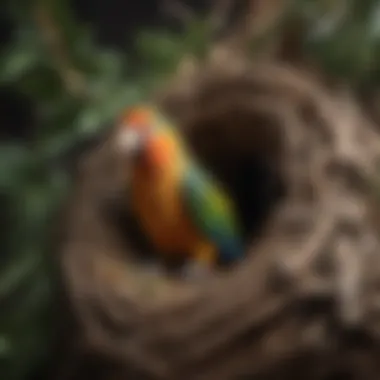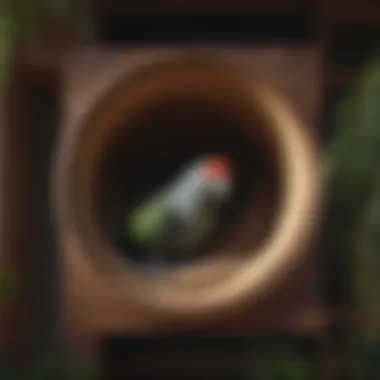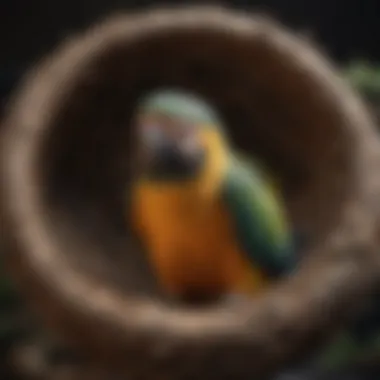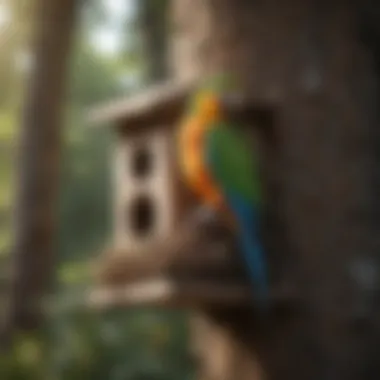Understanding Parrot Nest Boxes: A Comprehensive Guide


Intro
Parrots are intelligent creatures that require a supportive environment to thrive. One of the essential components of their habitat is the nest box. Understanding how to choose, maintain, and place parrot nest boxes can significantly enhance their breeding experience and overall well-being. This guide will provide insights into various aspects of nest boxes and the specific needs of your pet birds.
Understanding Your Pet
Understanding your parrot's behaviors, characteristics, and needs is fundamental to creating the right environment for them. Parrots are social, curious, and intelligent, which shapes their necessity for enrichment and suitable nesting.
Pet Behavior Basics
Parrots exhibit diverse behaviors. They are socially inclined and often seek interaction, either with humans or other birds. It's important to observe their communication language through body movements and vocalizations. Understanding these signals can help in fostering a positive environment.
Common Breed Characteristics
Different parrot species express unique behaviors. African Grey Parrots, for example, are known for their remarkable vocal abilities and intelligence. Budgerigars are more social and playful. Familiarizing yourself with your specific breed will enhance your ability to cater to its needs effectively.
Species-Specific Needs
Each parrot species has its nesting requirements. Larger parrot breeds tend to need more spacious boxes compared to smaller ones like Lovebirds. Researching the specific needs of your parrot can lead to a more effective nesting setup.
Nest Box Design and Materials
Selecting the right nest box involves several design and material considerations to ensure safety and comfort for your parrots.
Design Considerations
Nest boxes should have appropriate dimensions based on the size of your parrot species. A well-designed box should include a sturdy front entrance of suitable size and ventilation holes to ensure air circulation. Additionally, inside the box, there should be adequate space for your parrot to move around while feeling secure.
Materials
Choosing the right materials for a nest box is vital. Natural wood is often preferred due to its breathability and safety. However, ensure that the wood is untreated to avoid any harmful chemicals. Avoid materials that may splinter easily or contain toxic substances.
Placement of Nest Boxes
The location of your parrot’s nest box affects its comfort and willingness to breed.
Ideal Locations
Nest boxes should be placed in a quiet, low-traffic area of your home. This will help your parrots feel secure. Moreover, they should be mounted at a suitable height, allowing easy access while mimicking natural nesting environments.
Avoiding Disturbances
Ensure that the nesting area is free from potential disturbances, such as loud noises or other pets. Monitoring environmental conditions like temperature and humidity can contribute to a nesting-friendly environment.
Maintenance Requirements
Advancing the health and safety of your parrot also requires ongoing maintenance of the nest box.
Cleaning
Regular cleaning is essential to prevent the buildup of bacteria and parasites. Remove old nesting materials and replace them with fresh substrates as required. Use pet-safe cleaners to ensure the box remains hygienic.
Inspections
Frequent inspections of the nest box are necessary. Check for signs of wear and potential hazards such as loose parts, splinters, or accumulations of waste. Addressing these issues swiftly can prevent health risks to your birds.
Synthesizing the Information
Overall, understanding and implementing the right features for a parrot nest box is pivotal in providing a secure breeding environment for your birds. By focusing on their unique needs and preferences, you ensure that your pets will thrive in a conducive environment that fosters health and happiness. This guide serves as a foundation for both novice and experienced parrot owners who wish to enhance their understanding of avian care.
Prolusion to Parrot Nest Boxes


Parrot nest boxes play a crucial role in avian care, especially for those who own these intelligent birds as pets. This section emphasizes the importance of understanding the specific requirements and characteristics of nest boxes, as they directly influence the breeding and upbringing of young parrots. A well-designed nest box can provide a safe and comfortable environment where parrots can lay eggs and raise their chicks. It is essential for parrot owners to be aware of how nest boxes affect breeding success and the overall well-being of their birds.
Importance of Nesting
Nesting is a fundamental aspect of a parrot's life cycle. In the wild, parrots seek out safe spaces to build their nests, allowing them to reproduce successfully. For pet owners, replicating this natural instinct is vital. A suitable nest box not only supports breeding but also serves as a sanctuary where parrots can retreat for rest and comfort. It is vital to consider factors such as size, construction, and ease of access when selecting a nest box. Ensuring a nurturing environment can lead to healthier chicks and enhanced parental behaviors.
Types of Parrots and Their Nesting Needs
Different types of parrots have varying nesting requirements. Understanding these distinctions is important for any owner. For example, larger species like macaws typically require more spacious nesting environments compared to smaller birds, such as budgerigars. Here are some general needs based on species:
- Macaws: Prefer large nest boxes with ample floor space and height.
- Cockatoos: Benefit from boxes that offer both width and height for climbing.
- Conures: May thrive in smaller, enclosed spaces but still need good ventilation.
When choosing a nest box, consider the specific species and their natural nesting habits. This ensures that their unique instincts and behaviors are catered to, resulting in a more fulfilling breeding experience.
Design Considerations for Parrot Nest Boxes
Designing a functional and effective nest box for parrots requires careful thought. This section focuses on key aspects that pet owners should consider to create an ideal environment for their birds. Factors like dimensions, shape, and material choice play a crucial role in promoting healthy nesting behavior and ensuring the well-being of the parrots.
Dimensions and Shape
The size and shape of a nest box can greatly influence the comfort and safety of the parrots. Each species has its own specific requirements, which need to be addressed.
When determining the dimensions, consider the following:
- Species Size: Larger species like macaws require bigger boxes, while smaller species such as budgerigars can thrive in more compact spaces.
- Interior Space: The interior should allow enough room for the parrots to move comfortably. A cramped space will lead to stress.
- Access Points: Ensure there are adequate access points for the birds to enter and exit safely. This is especially important when the nest is for breeding.
Common shapes include rectangular and cylindrical designs. Rectangular boxes often provide more interior space, while cylindrical options can offer better stability. It is also essential to have sufficient ventilation to keep the environment inside the box safe and healthy.
Material Selection
The choice of materials is fundamental to the durability and functionality of the nest box. Common materials include wood, plastic, and metal, each with its own advantages and disadvantages.
- Wood: Natural wood is often preferred. It mimics the natural habitats of many parrot species. However, it should be untreated and free of toxic substances. Common woods used are cedar, pine, and plywood. Each wood type has different properties, so it is important to choose one that is safe and durable.
- Plastic: This option is easy to clean and maintain. However, some parrots may find plastic less comforting, and it might retain heat, which can be a concern in warmer climates.
- Metal: Not generally recommended for nesting boxes due to heat retention and lack of insulation. However, some metal components can be useful for structural support.
When selecting materials, also consider their resistance to weather elements, especially for outdoor boxes. Non-toxic paint and finishes can enhance durability without harming your parrots.
Choosing the right design and materials is essential for the success of a parrot's nesting experience. Paying attention to these details will ensure the comfort and health of your birds. Each decision should enhance the nest box's functional attributes while catering to the specific needs of the species you care for.
Placement of Nest Boxes
Placement of nest boxes is a crucial aspect of ensuring a successful breeding environment for parrots. Proper placement can significantly affect the comfort, safety, and accessibility for these birds. Factors such as indoor versus outdoor settings, height above the ground and environmental variables are all considerations that play a vital role in the well-being of the parrots. Choosing the right location for nest boxes is not merely about convenience; it influences the birds’ willingness to occupy and use them genuinely.
Indoor vs.
Outdoor Placement
When determining whether to place nest boxes indoors or outdoors, various factors need to be weighed.
- Safety: Indoor placements generally provide a more controlled environment. Predators such as cats or raccoons are less likely to gain access, offering a sense of security.
- Temperature Control: Indoors, you can manage temperature fluctuations more effectively. This is particularly important because extreme temperatures can be harmful to young hatchlings.
- Natural Light and Ventilation: Outdoor placement permits greater exposure to natural light and ventilation, which might be beneficial for the birds. However, direct sunlight can become problematic.
- Noise and disturbances: Indoor settings may reduce the stress from external sounds. Birds can be sensitive to loud noises or sudden movements.
Ultimately, the decision should account for the specific needs of the parrot species occupying the nest box, considering their natural habitats and behaviors.
Height and Environmental Factors
The height at which you place a nest box can have significant implications on its usage. Here are the crucial points to keep in mind:
- Accessibility: Nest boxes should be placed at a height that allows easy access for the birds. If they are too high or too low, the birds may resist using them.
- Predation Risks: Elevated placements can offer more safety from ground predators. Positioning nest boxes high in trees are common for wild parrots, mirroring natural conditions. This placement can also aid in protecting the young from potential threats.
- Humidity and Temperature: Environmental conditions like humidity and temperature can vary by height. Monitor the microclimate of the space where you plan to place the box. Too much moisture or the wrong temperature can lead to health issues for the parrots.
It is essential to observe the nesting behavior after placement. Depending on how the birds respond, adjustments may be necessary to improve nesting success.
Preparing the Nest Box


Preparing a nest box for parrots is crucial for ensuring a safe and comfortable environment for breeding. This preparation goes beyond simply placing a box in the right location. It involves meticulous attention to cleaning, maintenance, and selecting appropriate nesting materials. Each element contributes to the well-being of the birds.
Cleaning and Maintenance
Regular cleaning of the nest box is vital to prevent disease and discomfort. Before introducing any parrot to the nest box, ensure it is thoroughly cleaned. This applies to both new boxes and those previously used.
Steps for Cleaning:
- Remove old nest materials: Old bedding or nesting materials must be taken out to avoid contamination or parasites.
- Disinfect the interior: Use a mild, non-toxic disinfectant to wipe down the inside surfaces. This helps eliminate bacteria that could harm the birds.
- Rinse thoroughly: After disinfecting, rinse the box with clean water to remove any residue from cleaning products.
- Let it dry: Proper drying is essential to prevent mold growth.
Additionally, inspecting the nest box for any damages should be a routine practice. Small holes or cracks can compromise the safety of the parrot and attract unwanted pests.
Adding Nesting Materials
Nesting materials play a significant role in creating a cozy and appealing nesting environment. It is essential to choose materials that are safe and comfortable for the parrots.
Recommended Nesting Materials:
- Wood shavings: Soft and absorbent, wood shavings are ideal for providing insulation.
- Coconut husk: This material is natural, durable, and provides excellent nesting comfort.
- Grasses: Dried grasses can add an additional layer of warmth and texture.
- Paper products: Shredded paper or safe cardboard can also serve as nesting material.
When adding these materials, consider the specific needs of the parrot species you have. Different parrots might prefer different types of nesting materials based on their natural habitats.
Monitoring and Interaction
Monitoring and interaction are crucial when caring for parrot nest boxes. As intelligent creatures, parrots exhibit complex behaviors, especially during the nesting phase. Understanding these behaviors can significantly improve their welfare and promote a successful breeding environment. Effective monitoring allows owners to identify any issues that may arise, ensuring that the parrots feel secure and comfortable in their nesting space.
Observing Behavior
Observing the behavior of parrots in and around their nest boxes offers valuable insights into their health and well-being. Behaviors can vary widely based on species, but some common signs indicate that your parrot is comfortable. Look for signs of digging or rearranging nesting material, as well as the parrot spending time in or near the nest box. If a parrot frequently enters the box or brings in materials, it is likely preparing for breeding.
Take notes of any changes in behavior. A sudden increase in agitation or reluctance to enter the nest box can signal stress or health concerns. Regular observations help identify patterns that can inform care strategies.
Key Points about Observing Behavior:
- Monitor entry and exit frequency from the nest box.
- Watch for signs of distress, like loud vocalizations or aggressive posturing.
- Take note of how they interact with nesting materials.
Minimizing Disturbance
Creating a low-stress environment is essential for successful nesting. Minimizing disturbance means allowing parrots to engage in natural behaviors without unnecessary interruptions. It is advisable to avoid loud noises and sudden movements near the nesting area. This is particularly important during critical stages of breeding, when the female may be laying eggs or caring for young.
Consider positioning the nest box in a location that is less frequented by people or other pets. If you need to check on the nest box, do so quietly and quickly. Ensure that any essential maintenance or cleaning tasks are performed when the parrots are least active, usually early in the morning or late in the evening.
In addition, training pets or children to respect the nest area can reduce stress levels. Communicating about the importance of quietness near the nest box can foster awareness in households.
By focusing on these aspects of monitoring and interaction, parrot owners can enhance the breeding experience for their birds, ensuring a safe and nurturing environment.
Common Issues with Nest Boxes
Understanding the common issues associated with parrot nest boxes is essential for maintaining a healthy environment for both the birds and their caretakers. Identifying and addressing these problems can greatly enhance the success of breeding and the overall well-being of the parrots. This section will explore the predominant challenges that may arise and how to manage them effectively.
Pest Problems
Pest issues can undermine the effectiveness of nest boxes and pose threats to the health of the parrots. Common pests include mites, ants, and cockroaches, all of which may find their way into nesting areas. Their presence can lead to stress for the animals, disrupt nesting behaviors, and potentially transmit diseases.
To manage pest infestations, regular inspections are crucial. Here are some measures to take:
- Regular Cleaning: Regularly clean the nest box and surrounding areas to reduce debris that attracts pests.
- Use of Natural Deterrents: Consider using natural pest repellents that are safe for birds.
- Physical Barriers: Implement barriers like screens or specific nesting materials that discourage pests.
Taking a proactive approach can minimize pest-related challenges and provide a safer environment for your parrots.
Health Concerns for Parrots


The health of the parrots should remain a top priority when using nest boxes. Neglect or improper management of nesting sites can result in several health concerns, including respiratory issues, stress, and infections. One pressing issue is the accumulation of waste materials or mold inside the nest box, which can create a breeding ground for harmful bacteria.
It is important to keep the following health considerations in mind:
- Cleanliness: Ensure that the nest box is cleaned out and disinfected between uses to prevent contamination.
- Nesting Material Quality: Use safe, non-toxic materials for nesting that do not provoke allergies or respiratory conditions.
- Monitoring Bird Health: Regularly observe birds during breeding periods for signs of illness, such as lethargy or decreased feeding.
"Proper nest box management leads to healthier and happier birds, fostering a successful breeding environment."
Alternatives to Traditional Nest Boxes
Exploring alternatives to traditional nest boxes is essential for parrot owners looking to enhance the breeding environment. While standard nest boxes serve a specific purpose, various options might better suit certain species or individual parrot needs. Understanding these alternatives can offer unique benefits, promote natural behaviors, and cater to diverse environmental conditions that parrots face.
Natural Nesting Sites
Natural nesting sites are often the best option for parrots as they mimic the conditions the birds would encounter in the wild. Many parrot species prefer to nest in trees or hollows. When this option is available, it can significantly benefit their well-being. Here are some considerations regarding natural nesting sites:
- Availability: Ensure that suitable trees or vegetation are present in the vicinity. Parrots may thrive when given a choice to nest in environments they naturally favor.
- Safety: Avoid places where predators might easily reach. Ensure that the nesting site is elevated and concealed from potential threats.
- Species-Specific Needs: Different parrot species have specific preferences regarding nesting heights and site characteristics. Research the natural habitat of the species for best results.
A suitable natural nesting site can help reduce stress and encourage natural breeding behaviors in your pet parrots. This also allows owners to observe their birds in an enriching environment.
Artificial Nesting Solutions
If natural nesting sites are unattainable, artificial nesting solutions can be developed to simulate the required conditions. These alternatives can be particularly beneficial for pet owners who live in urban environments or regions lacking suitable trees. Here are some points to consider about artificial nesting solutions:
- Design Variability: Artificial nests can be customized based on the specific needs of various parrot species. They can range from simple wooden boxes to elaborate aviary-style nesting areas.
- Materials: Use non-toxic and durable materials that can withstand wear and tear. Avoid chemically treated woods and ensure the interior is safe for parrots.
- Ventilation and Access: Ensure proper ventilation to avoid overheating inside the nest. Access should be easy for the birds while minimizing potential disturbances from humans or pets.
Artificial nesting provides versatility in design and can be adjusted according to the specific needs of your parrots, ensuring a more comfortable setting for breeding and raising young.
Important Note: Always monitor any nesting solution for cleanliness and safety to protect the health of your birds. Regular maintenance is key to successful nesting.
Legal and Ethical Considerations
When engaging in the care and breeding of parrots, legal and ethical considerations are essential. These aspects ensure that the environment provided is not only compliant with regulations but also promotes the welfare of the birds. Failing to understand these considerations can lead to complications, both legally and ethically. Therefore, awareness and adherence to these guidelines are critical for all parrot owners.
Breeding Regulations
Breeding regulations are established to protect species and maintain animal welfare. Many regions have specific laws regulating the breeding of parrots. These regulations may dictate aspects such as:
- Permits and Licensing: Certain species require a permit to breed. Ensure you verify local laws to avoid penalties.
- Record Keeping: Breeders are often required to maintain detailed records of breeding activities. This includes information about the parent birds and the offspring.
- Species Protection: Some species are protected under conservation laws. Breeding these birds without a specific permit can result in legal action.
Understanding and following these regulations not only helps in maintaining legality but also contributes to responsible breeding practices. %Breeding responsibly ensures not only the well-being of your parrots but also upholds community standards.%
Conservation Implications
Conservation implications are another vital aspect to consider. The way parrots are bred and raised affects not just individual birds but entire populations. Responsible breeding can support conservation efforts in several ways:
- Supporting Endangered Species: Breeding programs can help preserve endangered parrot species, allowing them to thrive in captivity and potentially be reintroduced to their natural habitats.
- Reducing Wild Capture: By breeding birds, pet owners can reduce the demand for wild-caught parrots. This protects natural populations and their ecosystems.
- Education and Awareness: Breeders have a chance to educate the public about the needs of parrots, fostering greater appreciation and promoting better care practices.
Closure
In the realm of avian care, understanding the dynamics of parrot nest boxes is paramount. This article explored how the correct nesting environment significantly influences the well-being and reproductive success of these birds. Key elements such as design, placement, and maintenance can determine how effectively parrots use their nest boxes.
Nest boxes serve not only as safe havens for the breeding process but also as essential tools for enhancing the overall quality of life for pet parrots. The right conditions encourage breeding, promote health, and foster emotional well-being. Pet owners must weigh these factors when setting up their birds’ homes.
Key Takeaways
- Importance of Proper Design: The dimensions and material of the nest box directly affect comfort and safety.
- Nesting Needs by Species: Understanding the specific requirements of various parrot species ensures tailored care.
- Ongoing Maintenance: Regular cleaning and monitoring are critical for preventing health concerns.
“A well-designed nest box can make the difference between a successful breeding season and an unsuccessful one.”
Ensuring compliance with local breeding regulations and being mindful of conservation needs provides ethical backing to parrot care. Such considerations do not merely reflect personal responsibility but contribute to the broader ecological landscape in which these birds exist.
The future of parrot care will increasingly depend on our ability to integrate ethics, design innovation, and comprehensive understanding of their needs. By staying informed about advancements in bird care, including new materials and technologies, enthusiasts can better support their parrots in both domestic and wild environments.
Future Directions in Parrot Care
As the field of avian husbandry evolves, several future directions hold promise for enhancing the experience of keeping parrots.
- Research on Nesting Behavior: Ongoing studies into the natural nesting habits of parrots can refine how we design nest boxes. Future designs may replicate natural environments more closely, providing comfort and stimulating breeding instincts.
- Sustainability Practices: Increasing awareness around sustainability could influence material choice for nest boxes. Eco-friendly materials will soon become the norm, aiding conservation efforts while ensuring safe habitats for parrots.
- Technology Integration: As technology continues to advance, integrating monitoring systems in nest boxes can provide immediate feedback to owners on the environmental conditions within. This data will enable timely interventions, improving overall health outcomes for bird families.







